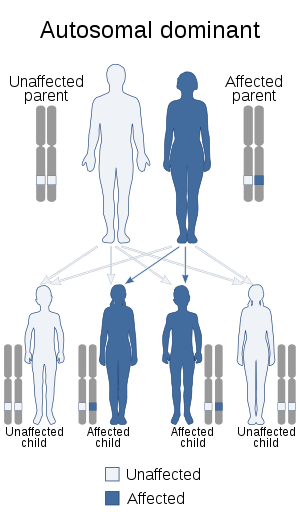Scalp–ear–nipple syndrome
Scalp–ear–nipple syndrome (also known as "Finlay–Marks syndrome") is a condition associated with aplasia cutis congenita.[2]
| Scalp–ear–nipple syndrome | |
|---|---|
| Other names | Finlay-Marks syndrome |
 | |
| Scalp–ear–nipple syndrome is inherited in an autosomal dominant manner[1] | |
Presentation
The key affected features of this condition[3] are described in its name.
Scalp: There are raised nodules over the posterior aspect of the scalp, covered by scarred non-hair bearing skin.
Ears: The shape of the pinnae is abnormal, with the superior edge of the pinna being turned over more than usual. The size of the tragus, antitragus and lobule may be small.
Nipples: The nipples are absent or rudimentary. The breasts may be small or virtually absent.
Other features of the condition[4] include: Dental abnormalities: missing or widely spaced teeth[5] Syndactyly: toes or fingers may be partially joined proximally [3][4][5][6] Renal abnormalities: renal hypoplasia,[7][8] pyeloureteral duplication [9] Eye abnormalities: Cataract,[7] coloboma of the iris and asymmetric pupils.[4]
Genetics
Candidate genes were identified for the Finlay-Marks Syndrome by probing gene expression databases using simple descriptors of the main organs affected.[10] Scalp-Ear Nipple Syndrome is caused by potassium-channel tetramerization-domain-containing 1 (KCTD1) mutations.[11] Evaluation of ten families affected by SEN syndrome revealed KCTD1 missense mutations in each family tested. All of the mutations occurred in a KCTD1 region encoding a highly conserved bric-a-brac, tram track, and broad complex (BTB) domain that is required for transcriptional repressor activity. The identification of KCTD1 mutations in SEN syndrome reveals a role for this BTB-domain-containing transcriptional repressor during ectodermal development.[11]
Diagnosis
Treatment
Epidemiology
The original report was of a family in Cardiff, United Kingdom.[3] There are subsequent reports of patients from the USA,[4][12][14][15][16] France,[7][8][9] Australia,[5] UAE,[13] India[17] and from Cuba.[18]
Etymology
The syndrome was first described by Finlay and Marks as “An hereditary syndrome of lumpy scalp, odd ears and absent nipples”.[3] It was termed "The Finlay-Marks (S.E.N.) Syndrome" by Aase in 1987,[19] “the Finlay Syndrome” by Le Merrer in 1991,[8] the “Scalp-Ear-Nipple Syndrome” by Edwards in 1994,[5] and “Finlay-Marks Syndrome” by Plessis in 1991.[7] The OMIM number OMIM 181270 was assigned in 1987 by Victor A McKusick with the name “Scalp-Ear-Nipple Syndrome” and alternative names “Finlay-Marks Syndrome” and “SEN Syndrome”.[20]
See also
- Say syndrome
- List of cutaneous conditions
References
- RESERVED, INSERM US14 -- ALL RIGHTS. "Orphanet: Scalp ear nipple syndrome". www.orpha.net. Retrieved 24 August 2017.
- Rapini, Ronald P.; Bolognia, Jean L.; Jorizzo, Joseph L. (2007). Dermatology: 2-Volume Set. St. Louis: Mosby. p. 892. ISBN 978-1-4160-2999-1.
- Finlay AY, Marks R (Oct 1978). "An hereditary syndrome of lumpy scalp, odd ears and rudimentary nipples". Br J Dermatol. 99 (4): 423–30. doi:10.1111/j.1365-2133.1978.tb06182.x. PMID 708615.
- Sobreira NL, Brunoni D, Cernach MC, Perez AB. Finlay-Marks (SEN) syndrome: a sporadic case and the delineation of the syndrome. Am J Med Genet A 2006 Feb 1;140(3):300-2.
- Edwards MJ, McDonald D, Moore P, Rae J (Apr 1994). "Scalp-ear-nipple syndrome: additional manifestations". Am J Med Genet. 50 (3): 247–50. doi:10.1002/ajmg.1320500307. PMID 8042668.
- Baris H, Tan WH, Kimonis VE (Apr 2005). "Hypothelia, syndactyly, and ear malformation--a variant of the scalp-ear-nipple syndrome?: Case report and review of the literature". Am J Med Genet A. 134A (2): 220–2. doi:10.1002/ajmg.a.30612. PMID 15712197. Erratum in: Am J Med Genet A 2005 Jul 1;136(1):114-5.
- Plessis G, Le Treust M, Le Merrer M (Oct 1997). "Scalp defect, absence of nipples, ear anomalies, renal hypoplasia: another case of Finlay-Marks syndrome". Clin Genet. 52 (4): 231–4. doi:10.1111/j.1399-0004.1997.tb02553.x. PMID 9383029.
- Le Merrer M, Renier D, Briard ML (1991). "Scalp defect, nipples absence and ears abnormalities: an other case of Finlay syndrome". Genet Couns. 2 (4): 233–6. PMID 1799422.
- Picard C, Couderc S, Skojaei T, Salomon R, de Lonlay P, Le Merrer M, Munnich A, Lyonnet S, Amiel J (Aug 1999). "Scalp-ear-nipple (Finlay-Marks) syndrome: a familial case with renal involvement". Clin Genet. 56 (2): 170–2. doi:10.1034/j.1399-0004.1999.560216.x. PMID 10517259.
- Van Steensel MA, Celli J, van Bokhoven JH, Brunner HG (Dec 1999). "Probing the gene expression database for candidate genes". Eur J Hum Genet. 7 (8): 910–9. doi:10.1038/sj.ejhg.5200405. PMID 10602367.
- Marneros AG, et al. (2013). "Mutations in KCTD1 Cause Scalp-Ear-Nipple Syndrome". The American Journal of Human Genetics. 92 (4): 621–6. doi:10.1016/j.ajhg.2013.03.002. PMC 3617379. PMID 23541344.
- Baris H, Tan WH, Hypothelia Kimonis VE (Jul 2005). "Am J Med Genet A 2005 Apr 15;134A(2) 220-2. Review. Erratum". Am J Med Genet A. 136 (1): 114–5.
- Al-Gazali L, Nath R, Iram D, Al Malik H (Apr 2007). "Hypotonia, developmental delay and features of scalp-ear-nipple syndrome in an inbred Arab family". Clin Dysmorphol. 16 (2): 105–7. doi:10.1097/mcd.0b013e3280147217. PMID 17351354.
- Steinberg RD, Ethington J, Esterly NB (Nov 1990). "Lumpy scalp syndrome". Int J Dermatol. 29 (9): 657–8. doi:10.1111/j.1365-4362.1990.tb02591.x. PMID 2272740.
- Taniai H, Chen H, Ursin S (Jun 2004). "Finlay-Marks syndrome: another sporadic case and additional manifestations". Pediatr Int. 46 (3): 353–5. doi:10.1111/j.1442-200x.2004.01905.x. PMID 15151556.
- Paik YS, Chang CW (Jun 2010). "Stahl ear deformity associated with Finlay-Marks syndrome". Ear Nose Throat J. 89 (6): 256–7. doi:10.1177/014556131008900606. PMID 20556735.
- Naik P, Kini P, Chopra D, Gupta Y (Jul 2012). "Finlay-Marks syndrome: report of two siblings and review of literature". Am J Med Genet A. 158A (7): 1696–701. doi:10.1002/ajmg.a.35389. PMID 22639454.
- Morales-Perelta E, Andres V, Campillo Betancourt D (2014). "Scalp-ear-nipple syndrome: a case report". Case Rep Med. 2014: 785916. doi:10.1155/2014/785916. PMC 3934383. PMID 24660003.
- Aase JM (1987). "The Finlay-Marks (S.E.N.) Syndrome: report of a new case and review of the literature". Proceedings of the Greenwood Genetic Center. 7: 177–8.
- OMIM. Online Mendelian Inheritance in Man. http://www.omim.org/ Accessed 26 August 2012.
External links
| Classification | |
|---|---|
| External resources |